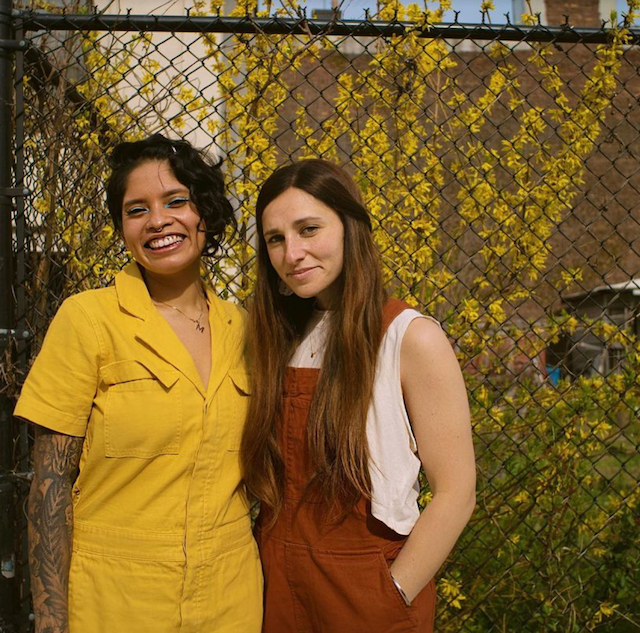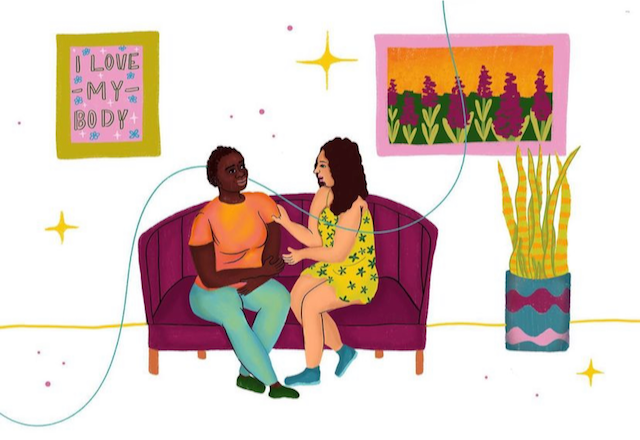Abortion can be hard for many adults to understand and process, let alone for kids. As with so many potentially major life events, they are often left in the dark without any comment or explanation as if nothing happened, or receive a rigid lecture from an authority figure imposing only their singular point of view.
The book What’s an Abortion, Anyway? (2021) proposes a new, more fluid and non-judgmental way to explain this event to the small ones.
What’s an Abortion, Anyway? is penned by Carly Manes, a white queer , Jewish full-spectrum doula and illustrated by Mar, a brown genderqueer cultural worker and full-spectrum doula who signs their works under the name Emulsify, a persona that uses art to help healing, advocating and bringing new words. It’s a game-changer of a book, particularly in a year that has seen virulent attacks against those seeking this basic reproductive healthcare.
In an interview for Scarleteen, Manes speaks on the creative process that led to the book, their experience of pitching it to established publishing houses, Emulsify’s approach to art and representation and drawing from professional experiences as abortion doulas and their point of view as LGBTQIA+ community members in creating this work.
Scarleteen (ST): How did you both come up with the idea to develop “What’s an Abortion Anyway?”? Did either or both of you draw from personal experience to develop the book?
 Carly Manes (CM): Mar and I are both abortion doulas and have been volunteering in abortion clinics for many years now. The reason that I started to write this book was because people I was supporting would ask me regularly if I had any resources or ideas around how to talk to their kids about their abortion that day.
Carly Manes (CM): Mar and I are both abortion doulas and have been volunteering in abortion clinics for many years now. The reason that I started to write this book was because people I was supporting would ask me regularly if I had any resources or ideas around how to talk to their kids about their abortion that day.
I spent months searching for resources that I could share with patients. The only content I was able to find was explicitly anti-abortion, that taught kids abortion was wrong, shameful, and dangerous. So, we created a resource that we could feel confident and proud of, one that was rooted in our values and the varying lived experiences of people who have abortions.
ST: Why is it important to talk to children about abortion? How can we communicate in language that is accessible to them?
CM: It’s important to talk about abortion with kids because it’s a part of life. Abortion is just one of many pregnancy outcomes. If we believe in talking to kids about birth and miscarriage , then we also must talk to them about abortion. When we don’t, we are inherently placing a value judgment on it as taboo, which increases stigma.
If we don’t talk to the kids in our lives about abortion, someone else will. Because abortion is so politicized, it’s important that we talk about it from our values and answer kids questions honestly and with compassion.
ST: What kind of research did you do for the book to assure it was medically accurate?
CM: We worked with abortion providers and sexual and reproductive health organizations that work with young people. More than 100 people helped shape this book by reading drafts and giving feedback (especially from their kids).
ST: Your work is non-judgmental and gender -inclusive. How is that part of the process, particularly given the polarizing times we are living in, and how unaccepting some segments of the population can be? And also, your writing also shows a diverse array of people from different paths who can become pregnant and those who are part of their families and lives. We don’t see this much on mainstream media. What was your writing process to make this as understandable as possible for those outside of the LGBTQIA+ community?
CM: It’s definitely been a journey. We believe one of the reasons that publishers and agents didn’t want to publish our book was because they didn’t understand why our book didn’t use the word “women.” Mar and I weren’t willing to compromise our values or invisibilize the many people who do not identify as women that have abortions.
There wasn’t much of a process that went into ensuring it was digestible for folks outside of the LGBTQIA+ community. Mar and I are both a part of that community, and this book is for us and our people. I hope that our book brings an awareness and normalization to abortion being a part of life for all people with the capacity to carry a pregnancy.
 ST: What were you looking for with the illustrations? Can you tell us about the process of working with Mar on them?
ST: What were you looking for with the illustrations? Can you tell us about the process of working with Mar on them?
CM: Mar is one of the most talented artists I have ever encountered. They infuse a vibrancy and life into each illustration they create, and that absolutely is the case with the illustration in this book. We wanted to ensure that the illustrations were bright and warm, as illustrations and images related to abortion are often dark and ominous, which is now how an abortion clinic actually feels.
The majority of images in the book portray people who have had abortions, all of them storytellers with We Testify.
ST: Given the constant winnowing of abortion rights and access in the United States, and recent policies like SB8, do you think we should also be talking to kids about the loss of, or threats to, abortion access? If so, how? And do you think that books like yours can help normalize abortion to more people on the whole and help turn around what's been happening?
CM: I absolutely believe we should continue to talk to kids about the political state of our world, in all facets, and that includes abortion. It’s a delicate balance of being honest with kids and also not burdening them with the weight of the world. Only each individual caretaker can determine what is right for their child based on the vastly different curiosities and capacities of all little ones.
In terms of how caretakers and adults can talk to kids about abortion restrictions, I think it’s similar to the way we address any and all political oppression taking place around the world. We talk to them about rights, bodily autonomy , and the importance of being a public advocate for the rights that each person is entitled to by the nature of their humanity.
I do think that a book like ours helps to normalize abortions, and I deeply hope that it changes the political trajectory of abortion rights and all reproductive rights in the United States (and world!). However, I’m hesitate to dream as big as the notion that normalizing abortion for young folks will stop repressive legislation. Laws like SB8 pass because a small minority of people with an unpopular opinion hold a lot of power. In order to prevent more legislation like SB8, we need to change how our governance systems work in addition to culture shifts.
ST: Is there anything else you want to share with our readers?
CM: Young people are smart, brilliant, and curious. They deserve medically accurate, age-appreciated information about their bodies and reproductive health care. I hope our book is amongst many abortion-related resources to come for young people.
“What’s an Abortion, Anyway?” is currently available for pre-order. It publishes in English in the fall of 2021 and in Spanish in the spring of 2022.
